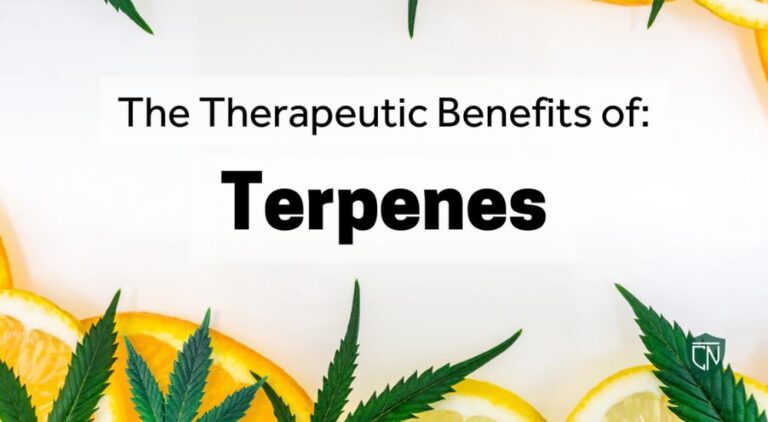Medically reviewed by Katherine Golden, RN
Written by Denise Rustning
You likely have heard of cannabidiol (CBD) and tetrahydrocannabinol (THC). But how about terpenes? These compounds play an important role in the cannabis plant’s health benefits.
Understanding the therapeutic effects of specific terpenes can help you find the right cannabis product for your needs.

Terpenes: The Plant Compounds You Already Know

Do you use lemon peel in your baking? Or have you found that lavender products help you relax?
Lemon, lavender and many other plants contain terpenes. Terpenes are aromatic molecules that help give certain plants their distinctive smells. These compounds also have therapeutic benefits.
For example, you’ve probably seen essential oils, candles, and even sleep masks that contain lavender for relaxation. The terpene linalool is one source of both lavender’s distinctive scent and relaxing effects. Many people also use citrus-based scents, like lemon, for a mood lift and energy. The lemon smell comes in part from limonene, a terpene contained in citrus peels.
Cannabis also contains many familiar terpenes, including linalool and limonene. These terpenes add to the plant’s therapeutic benefits.
Terpenes and the Entourage Effect
Cannabis flower (buds) and full spectrum products contain many other cannabinoids in addition to CBD and THC. They also contain different beneficial plant compounds, including terpenes, flavonoids and fatty acids. All these plant compounds work together to create an “entourage effect,” providing synergistic benefits beyond what a single compound could provide.
Boosting Your Health with Plant-Powered Terpenes
Have you heard of forest bathing? This practice involves spending quiet time in a forest, engaging all your senses, including your sense of smell. The practice began in Japan, where it’s called shinrin-yoku. Forest bathing reflects research showing how we benefit physically and mentally from time in nature. In fact, scientists are finding that both plant essential oils and terpenes—airborne plant compounds—play a central role in nature’s positive impact on human health.
The terpenes alpha-pinene and beta-pinene are found in many evergreen forest trees, contributing to forest bathing’s positive health impact. They’re also present in some cannabis plant strains.
Pinene isn’t the only terpene out there, though! Thousands of different terpenes exist in nature, and many different terpenes have been found in the cannabis plant.

Common Cannabis Terpenes

Some of the most common terpenes found in cannabis are listed below. It’s important to note that plants can contain multiple terpenes.
- Myrcene: Commonly found in cannabis strains/chemovars as well as in basil, lemongrass and ylang ylang. Myrcene helps promote sleep and may also reduce inflammation.
- Limonene: Well-known for providing a mood lift while reducing stress and anxiety, all by elevating serotonin levels in the brain.
- Linalool: Shown to reduce anxiety and depression, while also improving sleep quality. Linalool is also being tested in clinical settings to help reduce pain and nausea following surgery.
- Pinene: Found in evergreen trees, and also in many cannabis chemovars, pinene has anti-inflammatory and respiratory benefits.
- Beta-Caryophyllene: Found in black pepper, oregano, and cloves as well as cannabis. Beta-caryophyllene (also referred to as “caryophyllene”) is unique among terpenes found in cannabis because it can bind directly to CB2 receptors which are located throughout your body. Caryophyllene is being studied for its impact on reducing inflammation and pain, as well as its potential to protect against age-related cognitive decline.
- Alpha-Caryophyllene (Humulene): Also found in hops, humulene works together with caryophyllene to reduce inflammation. It also can suppress appetite.
Terpenes and Heat
Terpenes are affected by temperature.
The evaporation point is when terpenes start releasing volatile compounds, usually between 70-100 degrees Fahrenheit (°F). If you’ve ever walked through an herb garden on a sunny day, you’ve likely noticed you can smell the plants more strongly. That smell is in part due to terpenes.
When plant terpenes reach their boiling point, they are fully vaporized. This is at a much hotter temperature, over 300°F, though boiling points vary between different terpenes.
Terpenes are released when cannabis is smoked. Lighters need to produce a very hot flame in order to ignite materials—in fact, the temperatures on a lighter flame can range from 430°F to over 2,000°F. The temperature of a lighter flame is hard to control. Also, combustion can destroy many of the beneficial plant compounds as a result of the high heat.
As an alternative, some people prefer vaping cannabis flower so they can more precisely control the temperature to maximize terpene release. Some cannabis users describe this control like having a volume control on a radio. Lower temperatures create a quieter, more subdued effect, while hotter temperatures will give you a more intense result, in large part due to which terpenes are released.
Our “How to Use Cannabis” post provides more details.

Terpene Benefits in Topical Products
Terpenes provide numerous benefits without the addition of heat. After all, you don’t have to smoke the forest to gain benefits from forest bathing!
As we mentioned before, terpenes become available through evaporation that occurs at lower temperatures than smoking or vaping. Research supports aromatherapy’s impact on the body’s limbic system to positively impact mood and recovery. And one of the key components in aromatherapy essential oils is terpenes!
Our understanding of how these plant compounds contribute to the therapeutic benefits of cannabis is growing every day. Experts such as Jordan Person, LMT, LPN, continue to look at how to combine the benefits of cannabinoids such as THC and CBD with specific terpene profiles to achieve maximum relief. For example, she discusses how a cream containing both CBD and limonene helps to provide uplifting recovery following vigorous outdoor activities.
Using Terpenes in Edibles and Tinctures

The cannabinoids (THC and/or CBD, along with other cannabinoids) provide the strongest effect you feel with edibles, tinctures and swallowed pills. However, terpenes also add nuanced effects.
How does this work?
A full-spectrum CBD tincture made for sleep might be made from hemp with high levels of linalool. On the other hand, a full-spectrum CBD tincture designed for focus may have higher amounts of caryophyllene and limonene. The amount of CBD in each product may be the same, but the effects are different thanks to terpenes. (We’ll dive deeper into the connection between terpenes, cannabinoids and different cannabis strains in our next post.)
This video below provides a good explanation of the science behind terpenes in edible products.
You should always ask your physician first before medicating with any cannabis product.
Be sure to check out all of our great Club Nirvana products.
Have a question on how THC can work for your routine? Consult with a Cannabis Nurse today!


Have questions about cannabis? Our nurses can help! Call our free, anonymous hotline at 844-LEAF411 (844-532-3411).
The Leaf411 cannabis nurse hotline provides free education and directional support to the general public about the safe use of legal cannabis. We partner with select business members who meet our rigorous standards to extend our education and outreach efforts.






